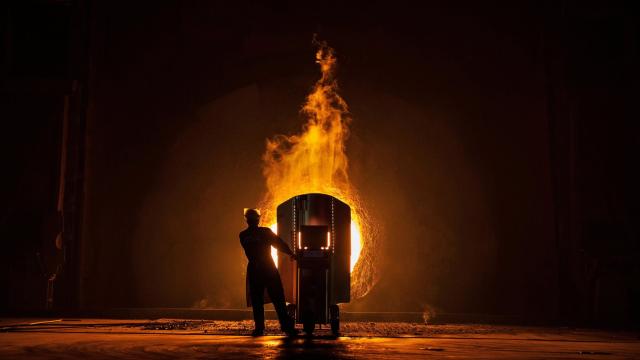We may be one step closer to seeing a worldwide revolution in making greener steel thanks to a new international agreement on tariffs.
Over the weekend, news broke that the U.S. and the EU had reached an agreement to lift tariffs on steel and aluminium imports. The tariffs had been imposed by former President Donald Trump. He ostensibly put them in place in the service of reviving the U.S. steel industry, which… didn’t work. In retaliation, the EU imposed their own tariffs on truly American exports like bourbon, Harley-Davidson motorcycles, and motorboats. The deal reached this weekend kicks those weapons in the trade war to the curb.
This might sound like boring news, but the details of this agreement contain some juicy climate nuggets. Namely, an emphasis on figuring out a way to make steel without carbon emissions. The U.S. and the EU are calling the new terms “the world’s first carbon-based sectoral arrangement” on the trade of steel and aluminium.
The steel industry is one of the toughest nuts to crack in terms of decarbonization. The iron and steel sectors together produce 2.8 gigatons of carbon dioxide emissions every year, which means they account for 8% of all of the world’s energy demand and 7% of its energy-related carbon emissions. If steel and iron production was a country, it would be roughly on par with India in terms of emissions. Steel production around the world overwhelmingly depends on coal-fired furnaces, making it a particularly dirty industry.
While the White House said they’re still hammering out details of this new proposal, Bentley Allan and Todd Tucker, two political scientists who broke down the agreement for the Washington Post, said that the agreement will see the U.S. and the EU working together for the next couple of years to set standards for measuring life-cycle emissions and putting restrictions on steel and aluminium that don’t meet those standards.
One thing that the two powers agree on now, however, is that Chinese steel is a lot more carbon-intensive than the stuff made elsewhere, and they’re imposing a tariff on Chinese-made metals now. Chinese steel relies heavily on coal-fired furnaces (as opposed to steel producers in the U.S., which use what are known as electric arc furnaces). The production and consumption of steel in China actually account for 17% of the country’s total emissions; since China is the world’s largest emitter, accounting for 27% of global emissions all by itself, Chinese steel is a hefty climate problem.
Emphasising how the dirty toll of Chinese steel allows the Biden administration to talk up its climate bona fides, and give a shout out to American-made products. In essence, Biden gets to have his climate and labour cake and eat it, too.
But as Allan and Tucker point out in the Post, China has shown that it’s pretty capable of harnessing green industrial policy when it needs to. And the impacts of the deal probably won’t just be limited to China. As the duo wrote, it also sends a “message to steel producers globally” to start figuring out how to clean up their act in order to be protected from more aggressive action from the U.S. and EU down the line.
Sometimes, climate wins come with strange political details: the dream of green steel gets one step down the line, and EU citizens get their bourbon and Harleys back at lower prices once again.
Editor’s Note: Release dates within this article are based in the U.S., but will be updated with local Australian dates as soon as we know more.
